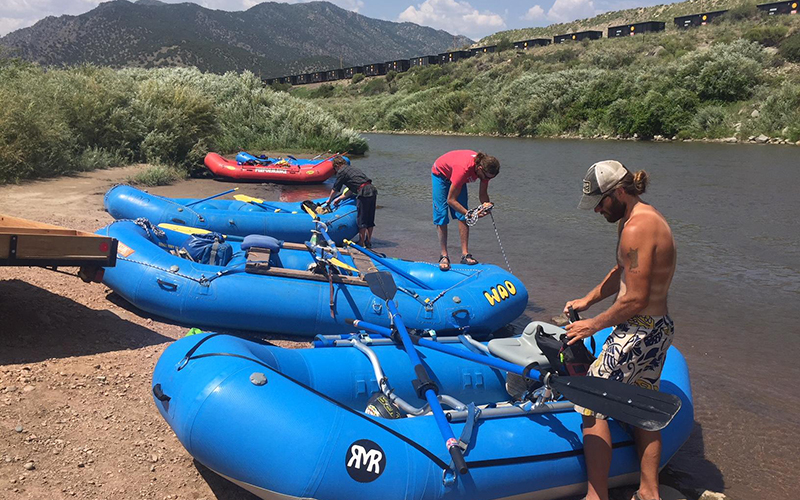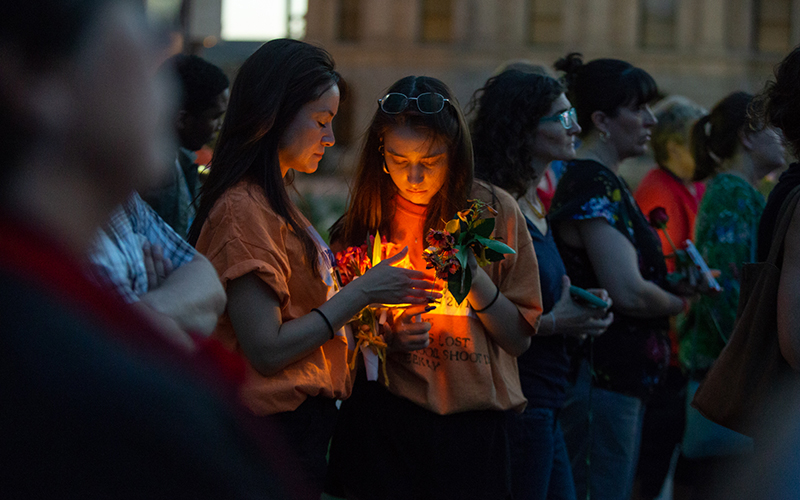
Jordan Poythress (right) prepares his raft to go down the Arkansas River near Cañon City. (Photo by Ali Budner/KRCC)
Colorado is called “the mother of rivers” for a reason: It has thousands of miles of waterways. That makes Colorado one of the most popular states for river rafting in the country. But like most of the West, a changing climate, drought and wildfires are taking their toll on this multimillion-dollar industry.
Jordan Poythress is at the banks of the Arkansas River near Cañon City, Colorado, on a sunny afternoon, helping a few customers shake their nerves before a run down the river’s rapids.
Poythress has been a river rafting guide for nearly a decade. But he still has to prepare himself for the particular challenges of navigating a river with low water.
“As the water comes down,” he said, “we have more obstacles to avoid, more rocks, more moves to be made. It is much harder for us.”
Poythress loves his job, but he said when the river is low, it’s not only rougher on the guides’ bodies, it also hurts their paychecks.
Guides get paid by the trip, not by the hour.
“So when the water goes down, our hourly goes way down,” Poythress said. “We’re working harder for the people out here.”
Right now, he said the Arkansas is running at about a third of the volume at this time last year.
Tony Keenan owns Whitewater Adventure Outfitters; he’s Poythress’ boss. Keenan has been in the rafting business since the ’80s, and he said there are always ups and downs.
This year, he said, hasn’t been the best.
“2016 was solid, 2017 was solid – poof! This year, snowpack numbers were significantly less,” Keenan said. “I mean, anybody that went skiing this year saw for themselves that snowpack was pretty thin, particularly in certain parts of the state.”
But it hasn’t been the worst year either, at least for the Arkansas River. Keenan said it has been manageable, mainly because of water released from reservoirs upstream.
It’s part of an agreement called the Upper Arkansas Voluntary Flow Management Program between rafting outfitters, fish and wildlife conservationists, state parks and water agencies. The deal aims to keep optimal flow in the river for various uses, including recreation.
The agreement is voluntary, so Keenan and his competitors are not guaranteed anything, but he said everyone knows the rafting business brings in tourism dollars for the whole area. He said Colorado Springs Utilities, for example, knows that people visit the area for outdoor recreation, such as hiking, climbing and rafting, so it behooves them to release enough water to make the river runnable.
“It’s good for them as well as us,” Keenan said.
Outfitters on some of Colorado’s other rivers have not been so lucky. Alex Mickel is the president of Mild to Wild Rafting and Jeep Trail Tours in Durango.
As of very recently, the company no longer offers raft trips down the local river – the Animas. The water’s just too low.
Unlike the Arkansas, the Animas River flows freely. There are no reservoirs upstream of Durango to release extra water from, so Mickel doesn’t have that kind of insurance policy.
The Animas actually had enough water for most of the summer, he said, “because even at low water, the river can be a ton of fun. There’s lots of maneuvering. There’s fun drops. It’s a great time.”
But the enormous 416 Fire near Durango, which began in June, squelched the area’s tourism. Mickel hoped his company could rebound after that, “but, well, that was really curtailed from the lack of flow that we ran into last week.”
He said if it rains more in the alpine areas near the Animas headwaters, they may be able to start taking raft groups out again through October, but they already will have missed peak season.
So, Mickel said, “it’s going to be a little more beans and rice this winter than normal.”
It’s an uncertain time as continued population growth and a changing climate put stress on Colorado’s streams and rivers. Rafting outfitters will have to keep going with the flow – even if that means no flow at all.
This story was produced by the Mountain West News Bureau, a collaboration between Wyoming Public Media, Boise State Public Radio in Idaho, Yellowstone Public Radio in Montana, KUER in Salt Lake City and KRCC and KUNC in Colorado.
This story is part of Elemental: Covering Sustainability, a new multimedia collaboration between Cronkite News, Arizona PBS, KJZZ, KPCC, Rocky Mountain PBS and PBS SoCal.
Follow us on Instagram.
